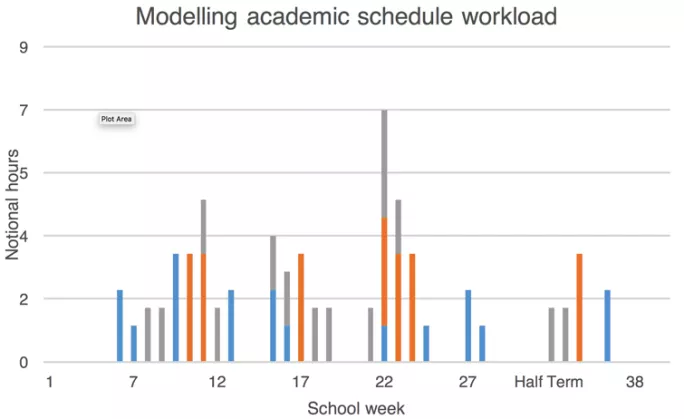How to spread out your teaching workload

I am often surprised when I hear school leaders talk about the “inevitable crunch points” in the school year, when - they suggest - there is no choice but to have teachers working particularly long hours. It is as if these critical times, when multiple deadlines coincide, are unavoidable.
This article explores a simple technique, developed at Southend High School for Boys, which has helped to ensure we plan and lead for effective workload management.
Teachers have to work hard, but it is perfectly possible to ensure that the workload is distributed evenly through the year. The benefits of planning for a balanced workload are obvious:
- Each of the tasks is undertaken to a higher standard
- Deadlines for tasks are nearly always met
- Staff ill-health absence is reduced
- Staff motivation is enhanced
These benefits can be made even clearer if we consider the opposite effects. When teachers face an annual cycle that has periods of very significant additional workload, it is no surprise to find:
- Some tasks are not completed to the highest professional standard
- Work may be completed late or not at all
- Colleagues are worn out by late nights or worry
- Teachers become disenchanted with their jobs
Teaching is hard work, but a balanced and sustainable workload can be achieved.
Identify all the additional tasks
The technique that we have developed maps all the additional tasks that teachers are required to complete. Each task is assigned a duration and the week when it is expected to be done.
Clearly, this can only be done if there is a complete and comprehensive list of all the tasks that teachers are required to do in your school. The list really does need to be complete, since one of the most important ways to relieve workload stress is to avoid unplanned additional tasks. The tasks really must be scheduled, otherwise, there’s no way of ensuring that the workload is even.
At our school, this work is done in March - ready for the following academic year. It deserves to be planned this far ahead, so the tool can be used to adjust any unforeseen pressure points.
The workload planning tool does not include lesson-planning or teaching and marking. It does include everything else.
The school has a clear policy on lesson-planning which involves minimal documentation.
We expect routinely high-quality teaching using strategies that are “low effort, high gain” in which the pupils do most of the work. Every teacher is guaranteed PPA time and additional time for leadership duties.
Lesson-planning, lesson-delivery and marking are the core duties of a teacher and can be sustained evenly through the year.
The challenge is to identify all the additional tasks that teachers are asked to do. Every school will be different. Our school list includes, for example:
- Parents’ evenings
- Report writing
- Tracking grades
- Ucas references
Assign a duration to each task on the calendar
Each of these tasks needs to be assigned to specified weeks on the school calendar. Each of these tasks is also assigned a fixed amount of time. This allows the distribution of workload to be properly examined. It also indicates the amount of time that colleagues should be spending on the task.
Every member of the SLT continues to be a practising teacher. We assign a duration that fits with our experience of actually doing the job.
For example, our parents’ evenings - as an 11-18 school, there are seven in a year - is afforded a three-hour time slot. Parents’ evenings occur on fixed days, so this additional workload is mapped to the week in which it occurs.
In our school, report-writing for a class is assigned a total of three hours on each occasion. This also allows for a brief written comment to be drafted - a maximum of two sentences per subject - and some additional marking that teachers may need to complete before a report can be written. The three hours are spread evenly across the fortnight before the deadline for submission. In some schools, leaders think it is good enough to spread the deadlines evenly through the year, but miss the impact of the work that is required prior to the deadline.
For interim tracking grades, an hour is allotted in the week before the deadline.
Plot the cumulative workload distribution
Having identified all the additional tasks, determined a duration and placed them on the draft workload calendar, we can now plot the result and see the impact.

Making the workload even
The first task after plotting the graph is to note where there are peaks and troughs. We were surprised. You will be too. When we first did it, we became acutely aware that the schedule that we’d created was very uneven. The example graph (above) has an obvious peak in Week 22.
There were things we could do about it, so our first response was to relocate some of those items, although our feeling is that in the beginning of the spring term there will be a number of coinciding deadlines that will be difficult to move.
The second thing that we did was realise that there tends to be a peak in the second or third week after the half-term holidays. This might be associated in the summer with exam classes, or in the spring term with report writing for exam classes. We made a decision based on that to modify our expectation for teachers in terms of setting homework for that time. We actually declared a key stage 3 “no-homework zone” for the week immediately after half term which then, of course, means no marking of that homework for those teachers in the second and third week after half term.
Every year, because the school year changes, we have to redesign that schedule and teachers have become quite used to the model that we use. The expectation that they will plan their workload across the week or fortnight before deadlines helps them not to leave everything to the last minute.
Dr Robin Bevan is headteacher at Southend High School for Boys
